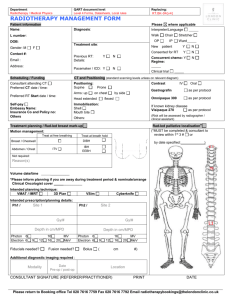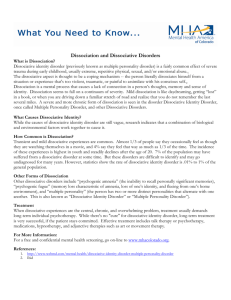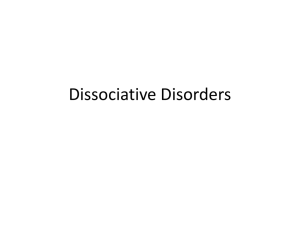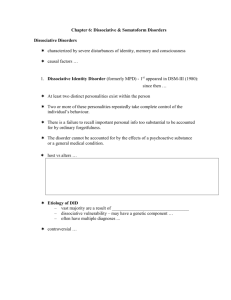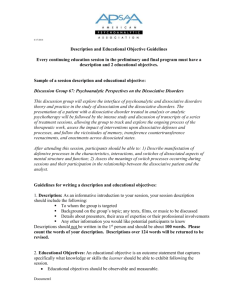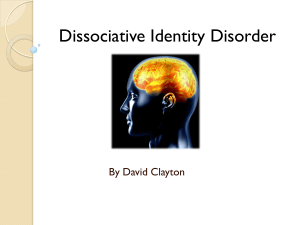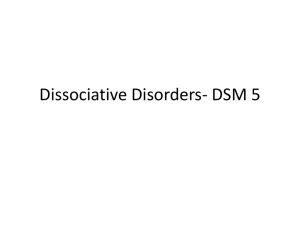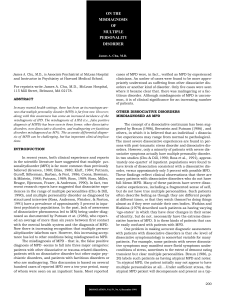Dissociative Identity Disorder
advertisement
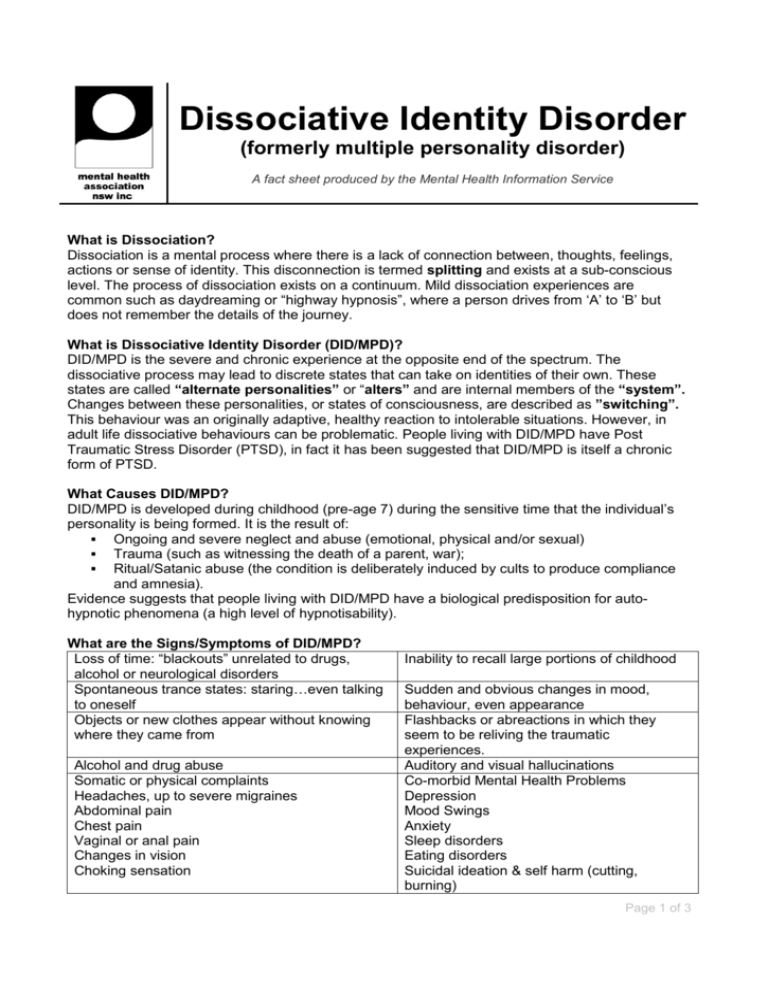
Dissociative Identity Disorder (formerly multiple personality disorder) A fact sheet produced by the Mental Health Information Service What is Dissociation? Dissociation is a mental process where there is a lack of connection between, thoughts, feelings, actions or sense of identity. This disconnection is termed splitting and exists at a sub-conscious level. The process of dissociation exists on a continuum. Mild dissociation experiences are common such as daydreaming or “highway hypnosis”, where a person drives from „A‟ to „B‟ but does not remember the details of the journey. What is Dissociative Identity Disorder (DID/MPD)? DID/MPD is the severe and chronic experience at the opposite end of the spectrum. The dissociative process may lead to discrete states that can take on identities of their own. These states are called “alternate personalities” or “alters” and are internal members of the “system”. Changes between these personalities, or states of consciousness, are described as ”switching”. This behaviour was an originally adaptive, healthy reaction to intolerable situations. However, in adult life dissociative behaviours can be problematic. People living with DID/MPD have Post Traumatic Stress Disorder (PTSD), in fact it has been suggested that DID/MPD is itself a chronic form of PTSD. What Causes DID/MPD? DID/MPD is developed during childhood (pre-age 7) during the sensitive time that the individual‟s personality is being formed. It is the result of: Ongoing and severe neglect and abuse (emotional, physical and/or sexual) Trauma (such as witnessing the death of a parent, war); Ritual/Satanic abuse (the condition is deliberately induced by cults to produce compliance and amnesia). Evidence suggests that people living with DID/MPD have a biological predisposition for autohypnotic phenomena (a high level of hypnotisability). What are the Signs/Symptoms of DID/MPD? Loss of time: “blackouts” unrelated to drugs, alcohol or neurological disorders Spontaneous trance states: staring…even talking to oneself Objects or new clothes appear without knowing where they came from Alcohol and drug abuse Somatic or physical complaints Headaches, up to severe migraines Abdominal pain Chest pain Vaginal or anal pain Changes in vision Choking sensation Inability to recall large portions of childhood Sudden and obvious changes in mood, behaviour, even appearance Flashbacks or abreactions in which they seem to be reliving the traumatic experiences. Auditory and visual hallucinations Co-morbid Mental Health Problems Depression Mood Swings Anxiety Sleep disorders Eating disorders Suicidal ideation & self harm (cutting, burning) Page 1 of 3 How Does DID/MPD Affect a Person’s Life? Many people living with DID/MPD can interact and function very normally. However, experiencing the symptoms of chronic defensive dissociation may lead to serious problems in work, social and daily activities. DID/MPD is often described as a highly creative “protective and survival” technique, allowing the individual some areas of healthy functioning during periods of extreme stress and dysfunction. People living with DID/MPD may dissociate to avoid situations, people places and things (such as smells, music, colours, etc) that are associated or remind them of the childhood trauma that created the disorder. The experience of any intense emotion (anger, fear, joy, sadness) may result in a conscious or sub-conscious decision to avoid and „switch‟. The array of symptoms and co-existing disorders (above) leads to difficulties with diagnosis. Research has documented that people living with DID/MPD have been misdiagnosed for up to seven years, treated for a variety of mental health problems before receiving accurate diagnosis and treatment. Is There Treatment for DID/MPD? The problems associated with dissociation are responsive to the appropriate therapeutic treatment. Medications have generally proven ineffective, except with the treatment of additional disorders such as anxiety, depression and post-traumatic stress disorder where the seratonin re-uptake antidepressants (Prozac, Aropax, Zoloft) have provided some relief. Selecting a specialist therapist in seeking treatment is vital. Therapy is very focused, intense and can continue from seven to twelve years. Essential to therapy is mapping the system, where the various alters and their purpose is identified. A person living with DID/MPD has a number of choices with the goal of therapy and the form of therapy used: GOALS OF THERAPY: Co-operation within the system. The therapist and person work towards a system where dissociation remains, but there is an understanding amongst the various alters as to when and where they may be active. This involves the establishment of the processes of coconsciousness, where two or more alters can be present at the same time, and co-presence, where the emotional influence of two or more alters are present at the same time. Integration is the process whereby the disjointed system becomes connected into one functional personality and the individual no longer experiences the hallucinations, switching, loss of time etc. This process is long and arduous, with therapy requiring a working through of the original trauma and purpose of the splitting that created each alter. The individual must learn new “survival”, coping techniques for experiences that they previously would avoid. Integration (pre, during and post) is experienced as a death and can involve physical, mental and emotional difficulties. Counselling and support is essential following integration to avoid regressive splitting and a return to dissociative behaviours. Partial integration can be an option for people who chose to continue with a dissociative life. The person living with DID/MPD may decide that only the dangerous, angry, self-harming alters will be integrated. FORMS OF THERAPY Hypnosis, a common treatment during which people relive the traumatic memories in a safe environment, ultimately learning to interrupt and control the dissociation process. Hypnosis is also sometimes used to access the alters for the purpose of joining and integration. EMDR is an acronym for Eye Movement Desensitisation and Reprocessing. Also known as “Reprocessing Therapy”, EMDR is a complex therapeutic approach that stimulates the brain‟s information-processing system. The traumatic experiences such as those of people living with DID/MPD are described to be stored in the brain without being processed sufficiently. EMDR Page 2 of 3 therapy brings these experiences to mind where the disturbing emotional and physical sensations are re-experienced. Re-processing in a safe environment, assists the person to have insight into their past, cognitively assess the situation and ultimately learn more adaptive behaviours for coping with stressful life experiences. This treatment is used extensively with PTSD and is suggested to be a very efficient (therapeutic goals are reached at a rapid rate) and successful (maintained) therapy. Where Can I get Further Information? For support group details and further information contact the NSW Mental Health Information Service on 9816 5688 or 1800 674 200 between 9.30am and 4.30pm, Monday to Friday. Contact the local Sexual Assault or Mental Health Service in your area. Sources of Information: Dissa (Dissociative Society of South Australia Inc.)1999; Dissociative Identity Disorder. Dubrow, L. Dubrow-Eichel, S. What is EMDR? From the EMDR Institute, Inc. Harvard College,1992. Dissociation and Dissociative Disorders. The Harvard Mental Health Letter. Mental Health Net – Dissociative Identity Disorder, Treatment. Sidran Foundation, 1994. What is Dissociative Identity Disorder? #Survivors on the Net – Australia! Help - Stop Abuse. Dissociative Identity disorder Defined. Disclaimer The information provided is to be used for educational purposes only. It should not be used as a substitute for seeking professional care in the diagnosis and treatment of mental health disorders. Information may be reproduced with an acknowledgement to the Mental Health Association NSW. This, and other fact sheets are available for download from www.mentalhealth.asn.au. This fact sheet was last updated in Spring, 2001. Mental Health Information Service Mental Health Association NSW Inc 60-62 Victoria Road Gladesville NSW 2111 Phone: 02 9816 5688 or 1800 674 200 (outside Sydney metro) Email: info@mentalhealth.asn.au Web: www.mentalhealth.asn.au Page 3 of 3

